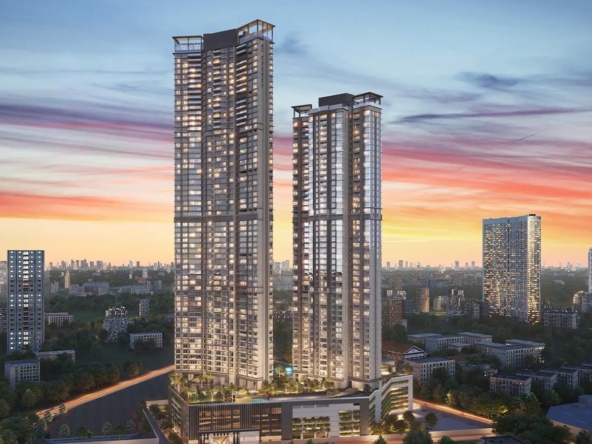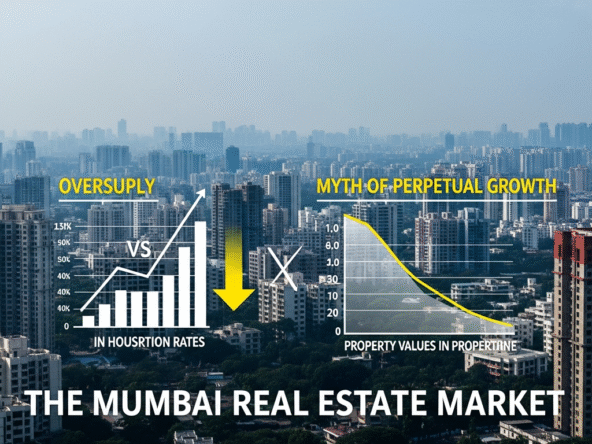From black money to redevelopment riches developer Harshul Savla speaks candidly about the business, the corruption, and why Mumbai property prices may never fall.
Mumbai:
The world of Mumbai real estate has long been cloaked in mystery, suspicion, and staggering sums of money. For decades, it has been accused of fueling corruption, hoarding black money, and exploiting homebuyers. Yet for all the public outrage, the business continues to expand, driving India’s most expensive urban housing market.
In a rare, unfiltered conversation, Harshul Savla , an academic-turned-developer and head of Soda Life Spaces, lays bare the truths of the industry—its profits, its contradictions, and its slow march toward transparency. A holder of seven degrees and the author of 24 books, Sabla represents a new generation of developers seeking legitimacy in a sector still battling a deeply entrenched image problem.
The Double-Edged Business of Building Wealth
“Builders make a lot of money,” Sabla admits at the outset. “We can build generational wealth—but we can also destroy the wealth we inherit.”
According to him, real estate remains a high-risk, high-reward business. “It’s like a no-limit casino table. You might walk in a monarch and walk out a pauper,” he says.
In Mumbai, a developer working on a 1,000-square-metre project typically invests about ₹50 crore in equity before sales begin. “If you’re putting in ₹50 crore and not making ₹50 crore in profit, there’s something wrong,” he says. “Given the risks—regulatory hurdles, litigation, constant policy changes—this is the most basic return one should expect.”
That 100 percent return, he insists, is not greed but survival. “Every project’s rules change mid-way,” he adds. “No feasibility report holds true till the end.”
Why Builders Are Loathed
Despite being one of the country’s largest employers, the industry’s image is abysmal. “People imagine a pot-bellied, gold-chain-wearing man with a gun in his pocket,” Sabla says with a laugh. “They forget that the same developer multiplies their net worth through redevelopment.”
He blames the industry’s poor public-relations strategy. “Mutual funds ran thousand-crore campaigns to change perceptions. Even eggs did a PR campaign. But developers never invested in image cleanup.”
The multiplicity of associations also weakens their voice. “Everyone wants to be president or secretary of their own builder group. We need one unified association that speaks for the industry.”
Sabla argues that every time a developer moves a project, “he moves 400 industries with him—from paint to plumbing. He’s building the nation, not just homes.”
Why Prices Won’t Fall
Sabla dismisses the hope that Mumbai home prices will ever meaningfully decline. “Think of cars,” he explains. “A Creta that cost ₹12 lakh now sells for ₹25 lakh. Have car prices ever fallen? No. A home, instead of using 80 industries like a car, uses 400. If all those components rise in cost, how can the final price fall?”
He argues that even if nominal prices stagnate, inflation makes them effectively cheaper over time. “If price increases don’t beat inflation, then yes, they fall notionally—but not in real terms.”
Emotions also drive the market. “People rarely sell property at a loss,” he notes. “They’ll lease it, mortgage it, but not sell it. Real estate is prestige, stability, and identity. Indians are emotionally attached to their homes.”
The Best Bets in Mumbai Property
For investors, Sabla’s pick is clear: old cooperative societies and chawl rooms in South Mumbai. “Buy them and wait for redevelopment,” he advises. “These 80- to 100-year-old buildings will collapse with a push. The government is pushing cluster redevelopment. Returns there can be three to four times the current value.”
He calls cluster redevelopment the “best investment class” in the city, outpacing even the stock market. “Those 50-lakh-rupee rooms can turn into multi-crore flats once redeveloped.”
Black Money: “It Should Stay Within the Country”
When asked whether black money has disappeared from real estate, Sabla laughs. “Will prostitution ever go away?” he retorts. “Black money should stay within the country—then it’s fine. The problem was when it went abroad, to Switzerland or Dubai. If it circulates here, it drives the economy.”
Still, he says, the nature of black money has changed. With developers seeking stock-market listings, many now prefer transparency. “Earlier the mindset was to hide profits and avoid taxes. Now they see they can make more by showing large sales and swelling balance sheets. A big valuation in the market adds far more wealth than hidden cash.”
He estimates that while black money hasn’t vanished, “it’s more of a growth inhibitor than an accelerator now.”
Corruption: “The Necessary Entry Barrier”
Perhaps Sabla’s most controversial view concerns corruption. “Corruption is good for real estate,” he says. “It acts as an entry barrier. If it didn’t exist, even more people would rush in.”
He distinguishes between outright scams and what he calls “speed money.” “Speed money exists everywhere—it’s the lubricant of approvals. Fraud, the scammy kind of corruption, has fallen from 100 percent to about 10 percent, thanks to digitisation, RTI, and social media scrutiny.”
The bigger menace, he argues, comes from professional extortionists who file information requests only to withdraw them later for payment. “RTI activism has become a full-time, lucrative business,” he claims. “Most complaints are withdrawn after settlements.”
The Banking “Mafia”
While developers are often painted as the villains, Sabla turns the spotlight on lenders. “The biggest googly is the banker himself,” he says.
He recounts cases where banks sanctioned ₹500-crore loans, collected processing fees, but failed to disburse the funds—crippling entire companies. “A single sanction-but-no-disbursal decision can destroy a 40-year-old business. You can’t move to another lender because your assets are already mortgaged.”
He calls for dedicated real estate banks, akin to infrastructure lenders, that understand the sector’s peculiarities. “NBFCs and AIFs borrow from banks and lend to the same developers those banks rejected—at 18 to 24 percent interest. That arbitrage is killing the industry.”
The Real Cost of Mumbai Homes
Are Mumbai prices high because of black money? “On the contrary, they’re 11 percent lower because of it,” Sabla jokes, referring to the stamp duty and GST that cash transactions avoid.
The real culprit, he says, is land. “When you do redevelopment, you give back huge value—extra area, rent, corpus funds. That’s your land cost. Add to that the premiums the BMC charges—the world’s richest local body—and your costs explode.”
He points out that just one levy, the fungible FSI premium, funded the city’s entire coastal road project. “Developers pay 40 different types of premiums. Between the government and the landlord, they take 70 percent of the project cost.”
As for buyers, he insists that the top-priced apartments are being bought by startup founders and stock-market winners, not by those parking unaccounted wealth. “The black-money customer is actually the smartest—he won’t overpay. He’ll buy land, plots, or second homes where prices are rational.”
Speed Money and Stakeholders
When it comes to bribes, Sabla says the system has evolved. “I’d have loved if it were per-square-foot—it would be easier to budget,” he quips. “Now it’s all relationship-driven. Approvals depend on a few people, and workloads have exploded. So, yes, speed money exists, and rates vary by project type and location.”
He believes everyone “wants a pound of flesh,” especially when they see record sales and ₹1-lakh-per-square-foot apartments. “No stakeholder is noble enough to say, ‘I’ll let this pass.’”
Why Projects Go Wrong
The biggest weakness of Indian developers, Sabla says, is over-commitment. “Builders must learn to say no,” he argues. “In our enthusiasm we over-bid or take up projects we can’t finish. Not every ball is meant to be hit for a boundary. We should learn to leave some well alone.”
He credits the Real Estate (Regulation and Development) Act (RERA) and the rise of corporate developers for imposing long-overdue discipline. “We now live in the present, not on stories of future price rises,” he says. “Corporate entrants brought sales discipline and professional marketing to the sector.”
A Changing Market: From Cash to Capital Markets
A major shift, Sabla observes, is the migration of developers toward the stock market. “Earlier nobody dreamed of listing. Now everyone wants to. The stock market has become the nuclear reactor fueling exponential growth.”
With listings come new metrics—like Gross Development Value (GDV)—that even old-timers never used. “We’re talking in billions now, chasing valuations rather than cash,” he says. “Cash, ironically, has become the dirt that slows the reactor.”
This new transparency, he insists, makes the sector healthier—even if black money still finds its way into land deals and ancillary areas.
Emotion, Infrastructure, and the Future of Mumbai
At the heart of it all, Sabla says, is emotion. “Mumbai real estate runs on emotion. People think from the heart. They want to live among people they know. Buying property is never just financial—it’s deeply personal.”
The city’s new infrastructure, especially the coastal road, could redefine its geography. “You’ll be able to reach any part of Mumbai in 30 minutes. That will expand the city’s spread and boost real estate across the region,” he predicts.
He believes Mumbai is entering a “rocket phase” of growth. “We were caught napping while Bengaluru and Gurugram surged ahead, but now Mumbai has had its espresso shot. It’s awake and running.”
From Builders to Nation Builders
Sabla’s broader message is one of recognition. “Remove real estate and infrastructure from the economy, and the country collapses,” he says. “Look at China—its double-digit growth was driven by infra and real estate.”
He calls the sector India’s “second-largest employer” and argues that attacking it is a “self-goal to the economy.”
Still, he acknowledges that reform is incomplete. “Corruption hasn’t vanished. Banking norms need fixing. But developers today are far more disciplined, professional, and accountable than ever before.”
For now, he remains bullish on Mumbai’s property market. “This city is like a blue-chip stock,” he says. “It doesn’t swing wildly like a small-cap. It grows steadily, and it always comes back stronger.”
“Learn to say no”
For all his optimism, Sabla’s advice to developers is rooted in restraint. “Our biggest flaw is not knowing how to say no,” he says. “We overbid, we overcommit, and then we can’t deliver. Not every ball needs to be hit for a boundary. Sometimes, a well-left is the best shot.”
In a sector where fortunes rise and fall with each project, that humility might be the rarest commodity of all.





